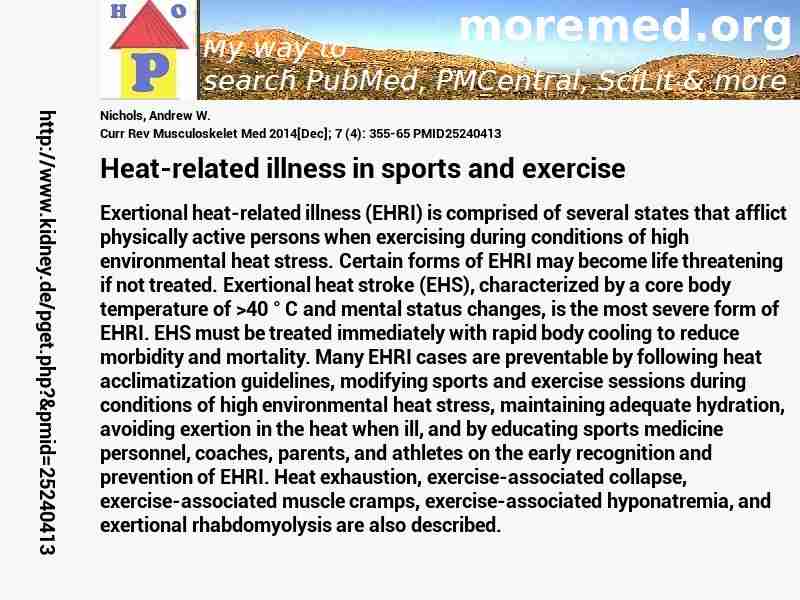
|
10.1007/s12178-014-9240-0
http://scihub22266oqcxt.onion/10.1007/s12178-014-9240-0

C4596225!4596225!25240413
 free free
 free free
 free free
Warning: file_get_contents(https://eutils.ncbi.nlm.nih.gov/entrez/eutils/elink.fcgi?dbfrom=pubmed&id=25240413&cmd=llinks): Failed to open stream: HTTP request failed! HTTP/1.1 429 Too Many Requests
in C:\Inetpub\vhosts\kidney.de\httpdocs\pget.php on line 215
|  
Warning: imagejpeg(C:\Inetpub\vhosts\kidney.de\httpdocs\phplern\25240413.jpg): Failed to open stream: No such file or directory in C:\Inetpub\vhosts\kidney.de\httpdocs\pget.php on line 117
 Curr+Rev+Musculoskelet+Med 2014 ; 7 (4): 355-65 Curr+Rev+Musculoskelet+Med 2014 ; 7 (4): 355-65
Nephropedia Template TP
gab.com Text
Twit Text FOAVip
Twit Text #
English Wikipedia
|
Heat-related illness in sports and exercise #MMPMID25240413Nichols AWCurr Rev Musculoskelet Med 2014[Dec]; 7 (4): 355-65 PMID25240413show ga
Exertional heat-related illness (EHRI) is comprised of several states that afflict physically active persons when exercising during conditions of high environmental heat stress. Certain forms of EHRI may become life threatening if not treated. Exertional heat stroke (EHS), characterized by a core body temperature of >40�� C and mental status changes, is the most severe form of EHRI. EHS must be treated immediately with rapid body cooling to reduce morbidity and mortality. Many EHRI cases are preventable by following heat acclimatization guidelines, modifying sports and exercise sessions during conditions of high environmental heat stress, maintaining adequate hydration, avoiding exertion in the heat when ill, and by educating sports medicine personnel, coaches, parents, and athletes on the early recognition and prevention of EHRI. Heat exhaustion, exercise-associated collapse, exercise-associated muscle cramps, exercise-associated hyponatremia, and exertional rhabdomyolysis are also described.�
  
DeepDyve
Pubget Overpricing | 
|